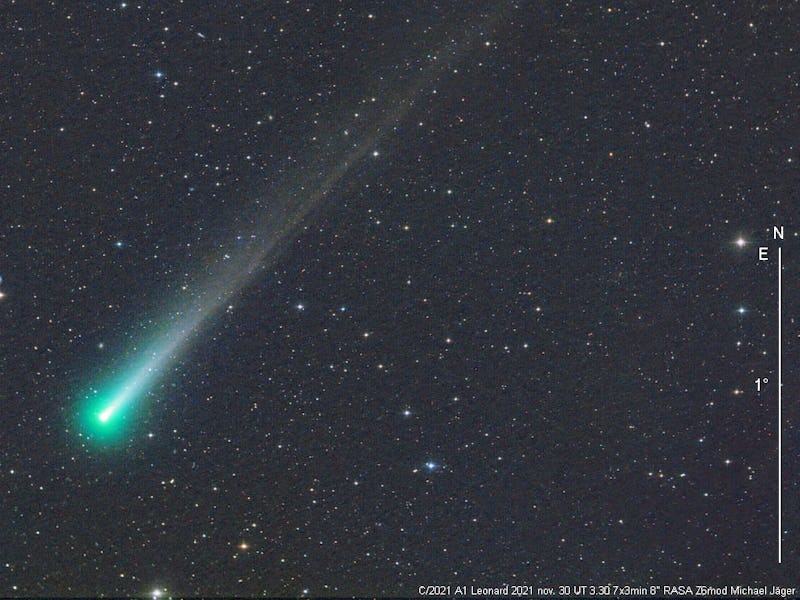This is your only chance to see newly discovered Comet Leonard
Leonard will visit the Solar System one last time before being flung out to outer space.

During the early morning hours of January 3, 2021, astronomer Gregory Leonard was scanning through the skies at the Mount Lemmon Infrared Observatory when he saw a smudge with a fuzzy tail.
“I saw an object that was definitely real,” Leonard tells Inverse. “It was tracking across four images against the background stars which appear stationary.”
As part of his work with the Catalina Sky Survey in Tucson, Arizona, which tracks near-Earth asteroids, Leonard and his team discover comets fairly often. However, this comet was going to come closer to the Sun than most other ones they had found.
“So because it's coming closer to the Sun, closer to the Earth, it’s brighter and it grows a longer tail,” Leonard says. “There's the promise that it could be bright enough for people to enjoy from their backyards.”
Comet C/2021 A1, also dubbed Leonard after its discoverer, is currently making its way towards the Sun. The comet will reach its perihelion, or its closest point to the Sun, on January 3, 2022.
What happens when you discover a comet
Following its discovery, Leonard and his team spent a few days figuring out the comet’s orbit.
“What we do is kind of like a team sport,” Leonard says.
After astronomers at the observatory discovered the comet, its position was shared with other NASA-funded projects such as the Minor Planet Center. Using the positional data, these institutions started building out the orbit of the comet using an automated process.
“It's at that time that we start to recognize, hey, it's an interesting trajectory,” Leonard says. “That's going to bring it close to the Sun, close to the Earth again.”
What is Comet Leonard?
Comet Leonard originated from the Oort Cloud, a cloud of icy bodies at the outer edge of our Solar System.
The comet may have already visited the Solar System before, around 75,000 to 80,000 years ago, according to Leonard.
“So it's already had one passage, but of course nobody was really around to record that event,” Leonard says. “And now it appears this comet is on what we call hyperbolic orbit so once it passes the Sun, it will be ejected from the Solar System and is going to be flown out for millions of years until likely stumbling into another star system.”
How close will Comet Leonard come to Earth
According to EarthSky, Comet Leonard come to within 21 million miles of Earth, which is significantly farther than the Moon and falling outside Earth’s million mile Hill Sphere, which is the area under which Earth influences a passing object.
However, as they’re made of ice and gas, comets tend to be more reflective than objects like asteroids, which means it could light up quite brilliantly if everything goes just right, Comet Leonard will be able to be seen by the naked eye, but a pair of binoculars or a small telescope will definitely reveal it.
A diagram of the Canes Venatici constellation.
How to see Comet Leonard
Comet Leonard will first be visible in the sky in December in pre-dawn hours, around 5:30 a.m. A pair of binoculars pointed in the direction of Canes Ventaci, which is located below the Big Dipper. Look between Canes and the constellation Boötes to find a fuzzy dot with a tail following behind it. These will be in the eastern portion of the sky.
At first the comet will be fairly dim, so a set of binoculars is needed. After the New Moon on December 4, the comet will be brighter and easier to find, and it could, potentially, eventually be seen with the naked eye. It will be closer to Boötes at this point, near its brightest star, Arcturus.
Stare near Arcturus to find Leonard.
After December 12, the comet won’t be visible in the morning sky, though it will make intermittent appearances in the evening sky, including appearing near Venus on December 17. Look just below that planet — which is one of the brightest objects in the sky — around sunset to spot it. It will be mostly visible in the southern hemisphere from mid-month on.
After its encounter with the Sun in early January, Leonard will become an interstellar comet like ‘Oumuamua. This means Comet Leonard is a literal once-in-a-lifetime event to see, as it won’t return.